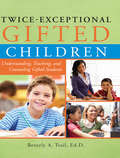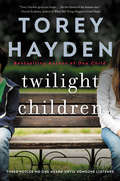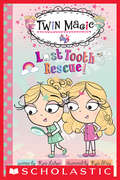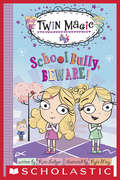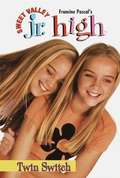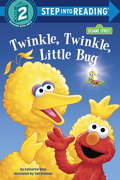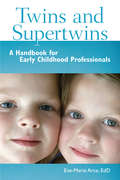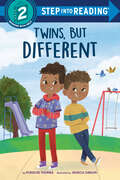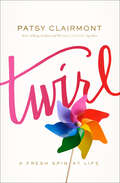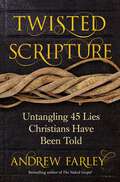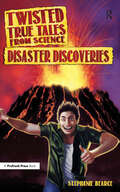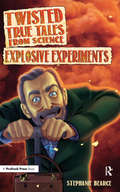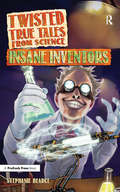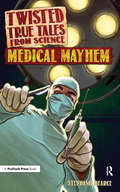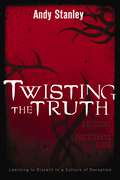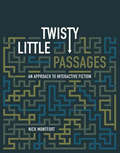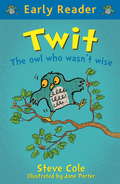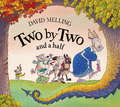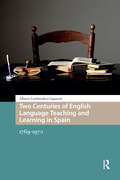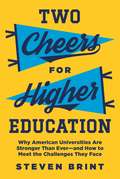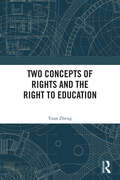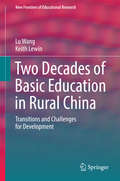- Table View
- List View
Twice-exceptional Gifted Children: Understanding, Teaching, and Counseling Gifted Students
by Beverly A. TrailGifted students with disabilities, also referred to as twice-exceptional children, need the strategies in "Twice-Exceptional Gifted Children: Understanding, Teaching, and Counseling Gifted Students" in order to find success in the regular classroom. By offering a thorough discussion of twice-exceptional students based on research into how gifted students with disabilities learn, the author helps teachers and education professionals develop a broad understanding of the complex issues associated with gifted students who have disabilities. This comprehensive text provides an overview of who these students are, how teachers can tap into their strengths and weaknesses, and what educational strategies should be implemented to help these students succeed in school and beyond. The book will guide a collaborative team step-by-step through the process of identifying students' needs, selecting modifications and accommodations, and developing a comprehensive plan to meet the diverse needs of twice-exceptional children. By implementing the strategies suggested in this book, teachers of twice-exceptional gifted students can ensure these students do not just survive in the classroom, but thrive.
Twilight Children
by Torey HaydenFrom the author of the phenomenal Sunday Times bestsellers 'One Child' and 'Ghost Girl', comes a startling and poignant memoir of three people's victimisation and abuse - and their heartbreaking but ultimately successful steps to recovery, with the help of Torey Hayden, an extraordinary teacher. Two children trapped in a prison of silence and a woman suffering in the twilight of her years - these are the cases that would test the extraordinary courage, compassion and skill of Torey Hayden and ultimately reaffirm her faith in the indomitable strength of the human spirit. While working in the children's psychiatric ward of a large hospital, Torey was introduced to seven-year-old Cassandra, a child who had been kidnapped by her father and was found dirty, starving and picking though rubbish bins to survive. She refused to speak, so Torey could only imagine what she'd been through. Drake, by contrast, was a charismatic four-year-old who managed to participate fully in his pre-school class without uttering a single word. Then, there was Gerda, eighty-two, who had suffered a massive stroke and was unwilling to engage in conversation with anyone. Although Torey had never worked with adults, she agreed to help when all other efforts had failed.
Twilight Children: Three Voices No One Heard Until a Therapist Listened
by Torey HaydenFrom the bestselling author of One Child comes the story of three of former special education teacher Torey Hayden’s most extraordinary challenges.Nine-year-old Cassandra, kidnapped by her father and found starving, dirty, and picking through garbage cans—is a child prone to long silences and erratic, violent behavior.Charming, charismatic four-year-old Drake will speak only in private to his mother—while his tough, unbending grandfather's demands for an immediate cure threatens to cause irreparable harm.And though she had never worked with adults, Hayden agrees to help fearful and silent eighty-two-year-old massive stroke victim Gerda—discovering in the process that a treatment's successes could prove nearly as heartbreaking as its limitations.
Twin Magic: Lost Tooth Rescue! (Scholastic Reader, Level 2)
by Kate LedgerGirls are sure to love this sparkly new reader series from Kate Ledger!*GLITTER ON THE COVER!*Lottie and Mia are twins with special magic powers--together, they can move objects with their minds! In the first book in this easy-to-read series, Lottie and Mia help a classmate recover her lost tooth. These Super Twins follow a trail of glitter and use their powers to save the day!
Twin Magic: School Bully, Beware! (Scholastic Reader, Level 2)
by Kate LedgerCheck out the second book in Kate Ledger's sparkly new reader series!Lottie and Mia are twins with very special magic powers. In the second book in the series, these Super Twins put their heads together to recover a ball that was thrown up into a tree during recess. It was thrown there by the new kid--who seems like one BIG bully! In the end, Lottie and Mia (and their friend Toby!) all befriend the school bully. *GLITTER ON THE COVER!*
Twin Switch (Sweet Valley Junior High #10)
by Jamie Suzanne Francine PascalJessica thinks the cool thing about having a twin is that you can always count on her to help you out. Especially when your twin is superperfect, ultrasweet, never-gets-mad Elizabeth. But ... Elizabeth doesn't understand why Jessica can't solve her own problems for once. Really, if she didn't love her sister, she might have to strangle her!
Twin: A Memoir
by Allen ShawnA heartbreaking yet deeply hopeful memoir about life as a twin in the face of autism. When Allen Shawn and his twin sister, Mary, were two, Mary began exhibiting signs of what would be diagnosed many years later as autism. Understanding Mary and making her life a happy one appeared to be impossible for the Shawns. At the age of eight, with almost no warning, her parents sent Mary to a residential treatment center. She never lived at home again. Fifty years later, as he probed the sources of his anxieties in Wish I Could Be There, Shawn realized that his fate was inextricably linked to his sister's, and that their natures were far from being different. Twin highlights the difficulties American families coping with autism faced in the 1950s. Shawn also examines the secrets and family dramas as his father, William, became editor of The New Yorker. Twin reconstructs a parallel narrative for the two siblings, who experienced such divergent fates yet shared talents and proclivities. Wrenching, honest, understated, and poetic, Twin is at heart about the mystery of being inextricably bonded to someone who can never be truly understood.
Twinkle, Twinkle, Little Bug (Step into Reading)
by Katharine Ross Tom CookeBig Bird, Elmo, and their friends learn something special about friendship from a little lightning bug in this Sesame Street Step 2 Step into Reading title. Beginning readers who are reading with help will enjoy this sweet story starring their favorite characters from Sesame Street.From the Trade Paperback edition.
Twins and Supertwins: A Handbook for Early Childhood Professionals
by Edd Eve-Marie ArceApproximately one in every thirty children born today is a twin or supertwin--a child of a higher-order multiple birth, such as a triplet or quadruplet. <P><P>With twins and supertwins an increasingly growing population in preschool classrooms, early childhood professionals have more questions and concerns regarding the best ways to care for and educate preschool-age children of multiple births. Twins and Supertwins addresses these issues and highlights the best program practices supported by recent research and study findings; includes information on physical, social, emotional, and language development; identifies unique needs of twins and supertwins; and offers guidance to create partnerships with families.
Twins, but Different (Step into Reading)
by Porsche ThomasModel and mother to twin boys, Porsche Thomas presents this Step 2 leveled reader about sibling differences and the importance of unconditional love. Perfect for children recognizing familiar words while sounding out new ones with help.All twins look and act the same, right?WRONG!August and Berlin are twins but they couldn't be more different. From their personalities, to their heights, to the way they like to play, these twins are definitely not the same. So, they never get along, right? WRONG AGAIN!For all their differences, they're a lot alike, too. Most importantly, they know that no matter how much they do or don't have in common, they make a perfect pair. Twin mom, model, and actress Porsche Thomas tells a story from the heart that's inspired by her own experience watching two twin boys grow up.Step 2 readers use basic vocabulary and short sentences to tell simple stories. They are perfect for children who recognize familiar words and can sound out new words with help.
Twirl: A Fresh Spin at Life
by Patsy ClairmontIs life making you so dizzy that you’re forgetting what’s most important?Patsy Clairmont loves a good twirl. The kind that will make a child fall to the ground, squeal with laughter, and then want to get up and spin in circles some more! However, there is a twirl where busy schedules and urgency create a different and unwanted variety of dizzy into our lives.Though hurry-up is part of the human dilemma and certain seasons bring more of it than others, if it becomes a lifestyle you might find yourself on the slippery slopes of bitterness, sadness, and depression. Patsy’s hope is to help her readers maintain a dynamic view on life—with activities and choices that lead to renewal and peace. So take a little stroll with Patsy Clairmont through Twirl, and allow her unique perspective and deep well of biblical wisdom to realign your spin on life.
Twisted Scripture: Untangling 45 Lies Christians Have Been Told
by Andrew FarleyLet's face it—the Bible contains passages that are challenging to interpret and can even incite fear. Sure, we want to believe God's grace applies to our unique troubles: addiction, divorce, habitual sins, or a feeling of distance from God because we don't measure up. Still, perplexing Bible passages eat at us. Bestselling author and radio host Dr. Andrew Farley is known to blitzkrieg legalistic and lifeless interpretations with his discerning take on controversial Scriptures. In Twisted Scripture, Andrew skewers sacred cows and shatters destructive lies, bringing the undiluted truth about God's love and grace in a colorful and conversational look at the most controversial passages in the New Testament. This book offers more than just encouragement and freedom. It may change everything about the way you see yourself and God.
Twisted True Tales From Science: Disaster Discoveries
by Stephanie BearceLondon was once covered in a fog so polluted that it killed 12,000 people. The Aleppo earthquake killed 230,000 people, and a wall of water mysteriously wiped out the whole town of Burnham-on-Sea. All of these were catastrophic disasters, but they led to important discoveries in science. Learn about how the earth turned to liquid in New Zealand and what happens when a tsunami meets a nuclear reactor. These stories may sound twisted and strange, but they are all true tales from science!Ages 9-12
Twisted True Tales From Science: Explosive Experiments
by Stephanie BearceTwo thousand years ago, Chinese scientists were looking for a medicine that would make them live forever. Instead, they blew up their lab and discovered gunpowder. Alfred Nobel blew up his laboratory twice before he discovered the formula for dynamite. Learn about the Apollo 13 and Challenger explosions and the strange space explosions caused by top secret Starfish Prime. These stories may sound twisted, but they're all true tales from science!Ages 9-12
Twisted True Tales From Science: Insane Inventors
by Stephanie BearceNikola Tesla was crazy smart. He invented the idea for cell phones in 1893, discovered alternating current, and invented a death ray gun. Of course, he also talked to pigeons, ate only boiled food, and was scared of women who wore jewelry. He was an insane inventor. So was Henry Cavendish, who discovered hydrogen, calculated the density of the Earth, and was so scared of people that he had to write notes to communicate. Sir Isaac Newton discovered the laws of gravity, believed in magic, and thought he could make a potion to create gold. These stories may sound twisted, but they're all true tales from science!Ages 9-12
Twisted True Tales From Science: Medical Mayhem
by Stephanie BearceGround-up mummy bones, leeches sucking human blood, and a breakfast of dried mouse paste. It sounds like a horror movie, but those were actual medicines prescribed by early doctors. Medical students studied anatomy on bodies stolen from graves and had to operate on people while they were awake. Learn about the medicines that came from poison and doctors who experimented on themselves and their families. It's a twisted tale of medical mayhem, but it's all true!Ages 9-12
Twisting the Truth Bible Study Participant's Guide: Learning To Discern In A Culture Of Deception
by Andy StanleyUnraveling the Lies That Twist Our LivesIn six insight-packed sessions, Andy Stanley exposes four destructive and all-too-prevalent lies about authority, pain, sex, and sin. They’re deceptions powerful enough to ruin our relationships, our lives, even our eternities—but only if we let them. Including both a small group DVD and participant’s guide that work together, Twisting the Truth untwists the lies that can drag us down. With his gift for straight, to-the-heart communication, Andy Stanley helps us exchange falsehoods for truths that can turn our lives completely around.
Twisty Little Passages: An Approach to Interactive Fiction
by Nick MontfortA critical approach to interactive fiction, as literature and game.Interactive fiction—the best-known form of which is the text game or text adventure—has not received as much critical attention as have such other forms of electronic literature as hypertext fiction and the conversational programs known as chatterbots. Twisty Little Passages (the title refers to a maze in Adventure, the first interactive fiction) is the first book-length consideration of this form, examining it from gaming and literary perspectives. Nick Montfort, an interactive fiction author himself, offers both aficionados and first-time users a way to approach interactive fiction that will lead to a more pleasurable and meaningful experience of it.Twisty Little Passages looks at interactive fiction beginning with its most important literary ancestor, the riddle. Montfort then discusses Adventure and its precursors (including the I Ching and Dungeons and Dragons), and follows this with an examination of mainframe text games developed in response, focusing on the most influential work of that era, Zork. He then considers the introduction of commercial interactive fiction for home computers, particularly that produced by Infocom. Commercial works inspired an independent reaction, and Montfort describes the emergence of independent creators and the development of an online interactive fiction community in the 1990s. Finally, he considers the influence of interactive fiction on other literary and gaming forms. With Twisty Little Passages, Nick Montfort places interactive fiction in its computational and literary contexts, opening up this still-developing form to new consideration.
Twit (Early Reader)
by Steve ColeEarly Readers are stepping stones from picture books to reading books. A blue Early Reader is perfect for sharing and reading together. A red Early Reader is the next step on your reading journey.Twit is a raggedy little owl whose brothers love to play tricks on him. It gets him into all sorts of trouble! But that all changes when Twit meets Norma, a clever little vole. All of a sudden, Twit's brothers had better watch out - Norma and Twit might just have a trick of their own to play...A charming, heart-warming Early Reader story from Steve Cole, author of the Astrosaurs books, and a talented DOCTOR WHO script writer.
Two By Two and a Half
by David MellingThe nursery class is lined up in twos and ready to go out with Miss Moo Hoo. Little Bat Jack is on his own at the back, but he doesn't mind. As they walk through the woods, they hear, feel and see something rather unusual... what on earth could it possibly be?'With playful text and a catchy refrain, Little Bat Jack proves that all the best things come in small packages.' - JuniorDavid Melling is one of the UK's best-loved author-illustrators. The Hugless Douglas series has sold over 1.4 million copies in 26 languages.
Two Centuries of English Language Teaching and Learning in Spain: 1769-1970 (Languages and Culture in History)
by Alberto Lombardero CaparrósThis book provides an exhaustive historical account of how the English language was taught and learnt in Spain over two centuries. Since its origins back in 1769 with the publication of San Joaquín de Pedro's 'Gramática inglesa' until 1970, a key year in European and World affairs. A period of time ample enough to accurately gauge the impact of this social phenomenon against the backdrop of social and political unrest which looms over the whole period but also with scientific breakthroughs that shaped our modern world. The history of ELT runs parallel to those events adopting diffferent mainstrem trends ranging from the Traditional or Latin-like approach to foreign language teaching to the so-called Grammar-Translation Method and the Direct or Oral Method. However, special attention is also given to 'minor' trends such as Ecclecticism which constantly overlaps the mainstream trends. This book is the first to take a close look at how the English language was taught and learnt in Spain for a two-century period when the French language was the Spaniard's first choice when it came to learning a foreign language.
Two Cheers for Higher Education: Why American Universities Are Stronger Than Ever—and How to Meet the Challenges They Face (The William G. Bowen Series #112)
by Steven BrintA leading expert challenges the prevailing gloomy outlook on higher education with solid evidence of its successesCrushing student debt, rapidly eroding state funding, faculty embroiled in speech controversies, a higher-education market disrupted by online competition—today’s headlines suggest that universities’ power to advance knowledge and shape American society is rapidly declining. But Steven Brint, a renowned analyst of academic institutions, has tracked numerous trends demonstrating their vitality. After a recent period that witnessed soaring student enrollment and ample research funding, universities, he argues, are in a better position than ever before.Focusing on the years 1980–2015, Brint details the trajectory of American universities, which was influenced by evolving standards of disciplinary professionalism, market-driven partnerships (especially with scientific and technological innovators outside the academy), and the goal of social inclusion. Conflicts arose: academic entrepreneurs, for example, flouted their campus responsibilities, and departments faced backlash over the hiring of scholars with nontraditional research agendas. Nevertheless, educators’ commitments to technological innovation and social diversity prevailed and created a new dynamism.Brint documents these successes along with the challenges that result from rapid change. Today, knowledge-driven industries generate almost half of U.S. GDP, but divisions by educational level split the American political order. Students flock increasingly to fields connected to the power centers of American life and steer away from the liberal arts. And opportunities for economic mobility are expanding even as academic expectations decline.In describing how universities can meet such challenges head on, especially in improving classroom learning, Brint offers not only a clear-eyed perspective on the current state of American higher education but also a pragmatically optimistic vision for the future.
Two Concepts of Rights and the Right to Education
by Yuan ZhengMost rights theories hold that the same act of a person or group cannot be driven by both a right and a duty. This book introduces the theory of initial rights and derived rights, demonstrating that an act is often the result of both. The key idea is that individuals and collectives have the right to fulfill their duty. However, general rights, those people are born with, do not originate from any duty, meaning their choices are not dictated by duties. As a result, access to education is a right, not a duty.The theory of initial and derived rights can extend beyond education to explain broader social dynamics, such as the relationship between government and citizens. This book applies the theory to various contexts, including children’s education, civic and moral education, school– student relationships, and teacher– student interactions. It explores how absolute rights relate to general rights, how the right to education connects to the right to establish private schools, and how opportunities for choice are linked to rights. While this is an abstract theoretical study, it offers practical insights for schools and teachers.The book will be of interest to researchers and students of rights theories and the philosophy of education, as well as educators.
Two Decades of Basic Education in Rural China
by Lu Wang Keith LewinThis book examines how educational change has progressed in three contrasting areas spread across China since 1990, exploring key issues concerning rural education in poor, rich and minority areas. Of the three areas covered in this book, the first is a rich one near Beijing; the second is in the northwest in Shanxi on the Loess plateau; and the third is in Sichuan on the high plateau leading to Tibet. Central issues include the impact of large-scale demographic change and migration, with increasing numbers of left-behind children in sending areas, and large increases in the numbers of inbound migrants in receiving areas; dramatic increases in the boarding of children in rural areas as a result of rural school merge; changing patterns of teacher deployment; recentralization of responsibilities for school financing; and growing concerns regarding horizontal and vertical inequalities in both access and participation.
Two Decades of TEL. From Lessons Learnt to Challenges Ahead: 20th European Conference on Technology Enhanced Learning, EC-TEL 2025, Newcastle upon Tyne and Durham, UK, September 15–19, 2025, Proceedings, Part I (Lecture Notes in Computer Science #16063)
by Sergey Sosnovsky Rafael Ferreira Mello Gerti Pishtari Kairit Tammets Tanya NazaretskyThe two-volume set LNCS 16063-16064 constitutes the proceedings of 20th European Conference on Technology Enhanced Learning, EC-TEL 2025, which took place in Newcastle upon Tyne and Durham, UK, September 2025. The total of 43 full papers, including 37 research papers, 4 blue-sky and 2 industry papers, as well as 16 demos and 32 posters papers presented in EC-TEL 2025 proceedings was carefully reviewed and selected from 195 submissions. They focus on all aspects of dynamic interdisciplinary field, bridging pedagogy, educational psychology, and digital technology.
